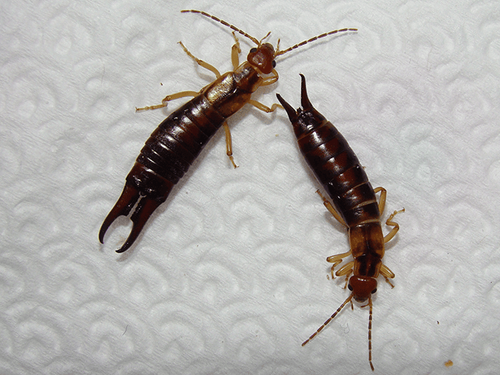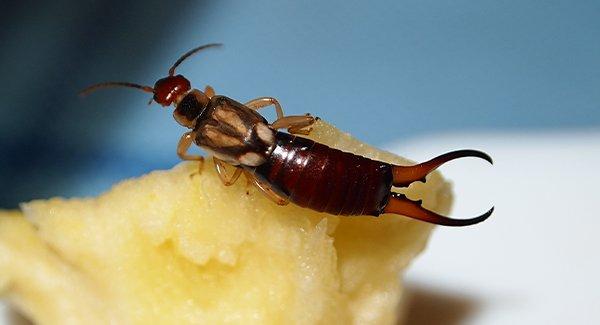Are Earwigs Dangerous to Cats, Humans, Dogs, Babies & Pets?

Potential Dangers of Earwigs

Pincer Pinch
Earwigs may look intimidating with their distinctive pincers, but they're not as dangerous as they appear. These pincers serve as their defense mechanism against predators. However, contrary to popular belief, they rarely use them to pinch humans or pets.
Purpose of Earwig Pincers
Earwigs primarily use their pincers for defense. When they feel threatened, they may raise their pincers in a defensive posture to deter predators.
Unlikeliness of Pinching Humans or Pets
Despite their pincers, earwigs are not aggressive creatures and typically only use them in self-defense. Their pinch is mild and usually not strong enough to break the skin. Additionally, they do not carry venom, so their pinch poses no significant harm to humans or pets.
Ear Canal Myth
One of the most persistent myths about earwigs is that they crawl into people's ears while they sleep. However, this misconception is just that—a myth. Earwigs lack any attraction to human ears and are not inclined to crawl into them.
Earwig Anatomy
Understanding the anatomy of earwigs helps dispel the ear canal myth. Earwigs have no particular interest in ears and are more commonly found in damp, dark places like gardens, mulch, or under rocks.
Ear Infection (Very Rare)
While it's theoretically possible for an earwig to enter the ear canal and become lodged there, resulting in an infection, such cases are extremely rare. The likelihood of this scenario is so low that it's considered more of an urban legend than a genuine concern.
Improbability of Ear Infection
The chances of an earwig finding its way into someone's ear, let alone causing an infection, are incredibly slim. The ear canal is not an appealing habitat for earwigs, making such occurrences highly unlikely.
Allergic Reaction (Possible)
Although earwigs aren't particularly harmful, some individuals may experience mild allergic reactions to their secretions. These reactions typically manifest as minor discomfort or irritation.
Potential for Allergic Reactions
In rare cases, individuals may develop allergic reactions to earwig secretions, resulting in symptoms such as itching or redness. If you experience any unusual reactions after coming into contact with an earwig, it's advisable to consult a doctor for appropriate treatment.
Are Earwigs Dangerous To Babies?
Earwigs are insects and when it comes to babies, concerns may arise regarding potential harm. While the idea of earwigs interacting with babies may cause concern for parents, it's important to understand that the risks associated with earwigs harming babies are minimal.
Earwigs Crawling on a Baby
It's natural for parents to worry if they find an earwig crawling on their baby. While it's unlikely for earwigs to intentionally seek out babies as prey, they may wander onto a baby's skin or clothing if they are in close proximity. However, it's important to note that the presence of an earwig on a baby is more of a nuisance than a direct threat.
The Risk of Baby Ingesting an Earwig
Another concern parents may have is the possibility of their baby ingesting an earwig. While this scenario is rare, it's essential to address. If a baby were to ingest an earwig accidentally, there might be a risk of choking, especially if the earwig is large. However, earwigs are not toxic, so ingesting one is unlikely to cause serious harm. At most, it might lead to mild digestive upset.
Earwig Pinching a Baby
One of the most feared scenarios is an earwig pinching a baby. Earwigs have pincer-like appendages known as cerci, which they use primarily for defense and mating purposes. If an earwig were to pinch a baby, it might startle the child, but the pinch itself is typically harmless. The force of an earwig's pinch is generally not strong enough to cause any significant injury to a baby's skin.
Earwigs are not aggressive insects, and instances of them causing harm to babies are extremely rare. By taking basic precautions such as keeping the baby's environment clean and free of insects, parents can minimize any potential risks associated with earwigs.
Are Earwigs Dangerous to Pets?
Earwigs are small insects that are often misunderstood, especially when it comes to their interaction with pets like cats and dogs. Let's delve deeper into how earwigs may or may not pose risks to your furry companions.
Cats and Dogs
Are Earwigs Harmful?
Earwigs, with their pincer-like appendages, might seem menacing, but they are generally harmless to cats and dogs. These insects do not possess venom or any harmful toxins that could seriously harm your pets.
Ingestion Risks
While it's possible for pets to ingest earwigs, it's not a common occurrence. In most cases, if a cat or a dog accidentally consumes an earwig, it shouldn't lead to significant health issues. However, it's essential to monitor your pet's behavior and consult a veterinarian if you notice any adverse reactions.
Other Pets
Birds and Rodents
For other common pets like birds and rodents, earwigs also pose minimal risk. Birds may occasionally consume insects, including earwigs, but they're unlikely to suffer any harm from doing so. Similarly, rodents like guinea pigs or hamsters may encounter earwigs in their habitat, but these insects are not a primary concern for their well-being.
Consulting a Veterinarian
If you're worried about how earwigs might affect your specific pet, whether it's a bird, rodent, or any other creature, it's always best to consult with a veterinarian. They can offer tailored advice based on your pet's species, size, and individual health needs.
In conclusion, while earwigs may startle pet owners with their appearance, they generally pose little to no threat to cats, dogs, and other common household pets. Monitoring your pet's interactions with insects like earwigs and seeking professional guidance when necessary ensures their well-being and your peace of mind.
Understanding Earwig Anatomy and Habits
Physical Characteristics
Earwigs are fascinating insects known for their distinctive appearance. Here are some key features:
Pincers: One of the most recognizable aspects of earwigs is their pincers, formally known as cerci. These are located at the end of their abdomen and are often used for defense and capturing prey.
Wings: Earwigs possess two pairs of wings. The first pair, known as tegmina, are hardened forewings that provide protection for the delicate hindwings. While earwigs are capable of flight, they typically rely more on their pincers and legs for movement.
Diet
Understanding what earwigs eat is essential for managing their presence:
Decaying Matter: Earwigs are scavengers and often feed on decaying organic matter. This includes fallen leaves, dead insects, and other detritus found in their environment.
Plants: While earwigs primarily consume decaying matter, they may also feed on plants. They are known to nibble on the leaves, flowers, and fruits of various plants, though they typically prefer softer, more tender vegetation.
Behavior
Exploring the behavior of earwigs sheds light on their habits and lifestyle:
Nocturnal: Earwigs are primarily nocturnal creatures, meaning they are most active during the night. This behavior helps them avoid predators and reduce the risk of desiccation during hot, sunny days.
Attraction to Moisture: Earwigs are strongly attracted to moisture. They often seek out damp environments such as under rocks, in mulch, or within decaying vegetation. This preference for moisture helps regulate their body temperature and ensures they have access to suitable habitats for breeding and foraging.
Dealing with Earwig Infestations
Earwigs are pesky little insects that can invade your home, causing annoyance and potential damage. Understanding how to identify signs of an infestation, prevent their entry, and effectively remove them is crucial for maintaining a comfortable living environment.
Signs of an Infestation
If you suspect you have an earwig infestation, watch out for these telltale signs:
- Nighttime Sightings: Earwigs are nocturnal creatures, so spotting them scurrying around at night, especially in damp areas like bathrooms and kitchens, is a clear indicator of their presence.
- Damp Areas: These insects are attracted to moisture, so finding them in damp spots around your home, such as basements or near leaky faucets, is another sign.
Prevention Strategies
Preventing earwigs from entering your home is the first line of defense. Here are some effective strategies:
Sealing Entry Points
- Cracks and Gaps: Seal any cracks or gaps in your home's exterior walls, windows, and doors using caulk or weather stripping. Earwigs can squeeze through tiny openings, so thorough sealing is essential.
- Around Pipes: Inspect and seal gaps around pipes, utility lines, and vents where earwigs can gain entry.
Addressing Moisture Issues
- Leaky Faucets: Repair any leaky faucets or pipes promptly to eliminate sources of moisture that attract earwigs.
- Dehumidifiers: Use dehumidifiers in damp areas of your home to reduce humidity levels, making the environment less hospitable for earwigs.
How To Get Rid Of Earwigs?
If you find yourself dealing with an earwig infestation despite your prevention efforts, here are some methods to consider:
Natural Methods
- Traps with Bait: Set up DIY traps using materials like rolled-up newspaper or cardboard tubes filled with damp newspaper as shelters, baited with something attractive to earwigs, such as vegetable oil or fish oil. Check the traps regularly and dispose of captured earwigs.
- Diatomaceous Earth: Sprinkle food-grade diatomaceous earth in areas where earwigs are active. This natural substance damages the exoskeleton of insects, leading to dehydration and death.
Insecticides
- Last Resort: If the infestation is severe and other methods haven't been effective, you may need to resort to insecticides. Choose products specifically labeled for earwig control, and always follow the instructions carefully to ensure safety for you, your family, and pets.
Frequently Asked Questions (FAQ'S)
Q. Are earwigs dangerous to humans?
Generally, earwigs are not harmful to humans. They may pinch if provoked, but their pincers are not strong enough to cause significant harm. They do not spread diseases or pose serious threats.
Q. Can earwigs bite or sting?
Earwigs have pincers called cerci, which they use for defense and capturing prey. While they can pinch if handled, their pincers are not venomous, and their bites are usually harmless to humans.
Q. Do earwigs crawl into ears while people sleep?
Contrary to popular belief, earwigs do not typically crawl into ears. They prefer dark, damp environments like under rocks or in soil. Ear infestations are rare and usually occur due to other factors.
Q. What diseases do earwigs carry?
Earwigs are not known to transmit diseases to humans. They primarily feed on decaying organic matter, plants, and insects, rather than seeking out human hosts. Therefore, the risk of disease transmission is minimal.
Q. How can I control earwig infestations?
To control earwigs, reduce moisture and shelter around your home, such as removing debris and sealing cracks. Sticky traps, diatomaceous earth, and insecticides can also be effective for managing infestations if necessary.
